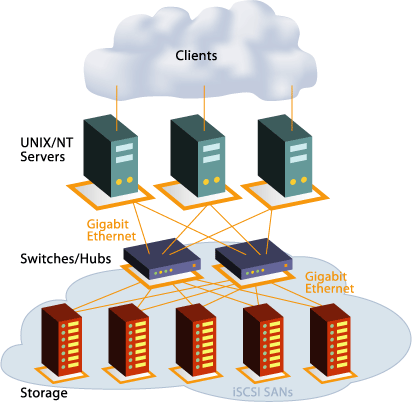iSCSI SANs Compared
How Does iSCSI Work?

iSCSI utilizes existing Ethernet infrastructure to run a modified version of the SCSI protocol over TCP/IP. Source: Adaptec
I already outlined the basics of iSCSI: An iSCSI initiator connects to an iSCSI target, which eventually results in a new drive becoming available on the initiator’s host machine. The beauty of this is the way the new storage partition can be accessed: it appears as if it were locally installed in the host machine, although the iSCSI target can be located anywhere within your network. The only real limitation is network performance, which means that you shouldn’t use anything slower than Gigabit Ethernet - though a simple wireless network is technically capable of hosting an iSCSI deployment.
While this sounds simple, there is a certain workload and complexity behind it. iSCSI targets typically are Unix-based server-class systems, or similar, customized solutions. The operating system, however, normally goes on a "diet" to allow it to fulfill its storage purpose.
The initiator can be any Windows XP or Vista PC, a Windows 2003 or 2008 server, or a machine based on any other operating system for which iSCSI initiator software is available from the OS vendor or a third party. There are iSCSI initiators from most Linux distributions and VMWare ESX, for example. Microsoft provides initiator software, which has to be used to map the target into the host system. There are still hardware iSCSI initiators, such as those by QLogic, which make sense in high-performance environments where the host PC shouldn’t be taking care of packaging SCSI into TCP/IP. Most initiators even allow booting an operating system installed on a remote iSCSI target instead of a local hard drive.
Configuration of the storage iSCSI drives, partitions or volumes - the technical terms can vary - happens on the side of the iSCSI target, which decouples the management from the host system. This approach allows administrators to configure and test new iSCSI target appliances, and deploy them into a productive state with very little effort: just run the iSCSI initiator and adjust existing network shares, and you’re done. Since iSCSI targets typically are fully featured PCs, they come with all the features you would get from a locally installed RAID array. Multiple drives, caching, RAID arrays and sophisticated features such as battery backup for cached data, RAID level migration, online capacity expansion and more are usually available on iSCSI targets, because they’re based on the same RAID hardware you might be familiar with on the PC side: SATA and SAS. As a result, every administrator with experience in handling RAID configurations will be able to deal with an iSCSI solution with very little training. Welcome to the world of SAN, which utilizes networking to overcome the mostly physical, but also practical constraints of conventional storage.
iSCSI of course also has disadvantages. If you aren’t already using rack-mountable hardware you’ll probably have to move to it if you want to get iSCSI deployed properly. Most of the professional appliances are laid out for easy deployment and upgradeability. Adaptec’s SnapServer 700i family, which we talk about on the following pages, is an excellent example. The device by Enhance Technology, however, tries to beat Adaptec by providing a pedestal product for small businesses. It doesn’t require a professional IT infrastructure, and it comes at a fraction of the cost.
Stay On the Cutting Edge: Get the Tom's Hardware Newsletter
Get Tom's Hardware's best news and in-depth reviews, straight to your inbox.
Current page: How Does iSCSI Work?
Prev Page iSCSI Appliances By Adaptec And Enhance Technology Next Page Adaptec SnapServer 720iMost Popular

